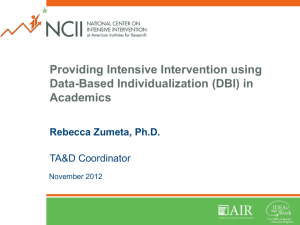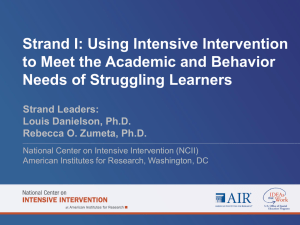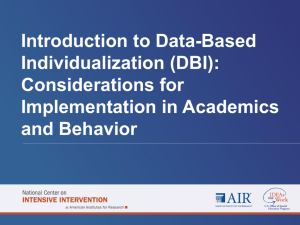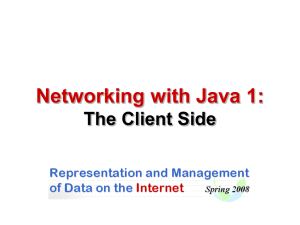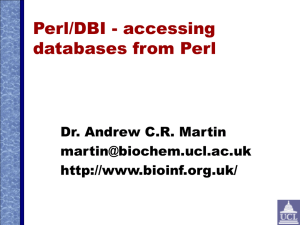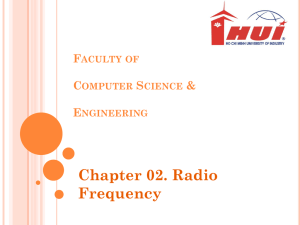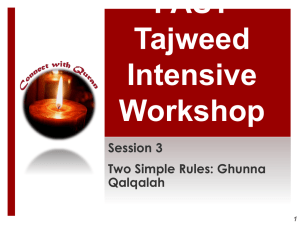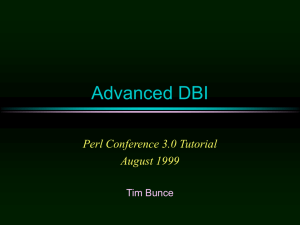- National Center on Intensive Intervention
advertisement
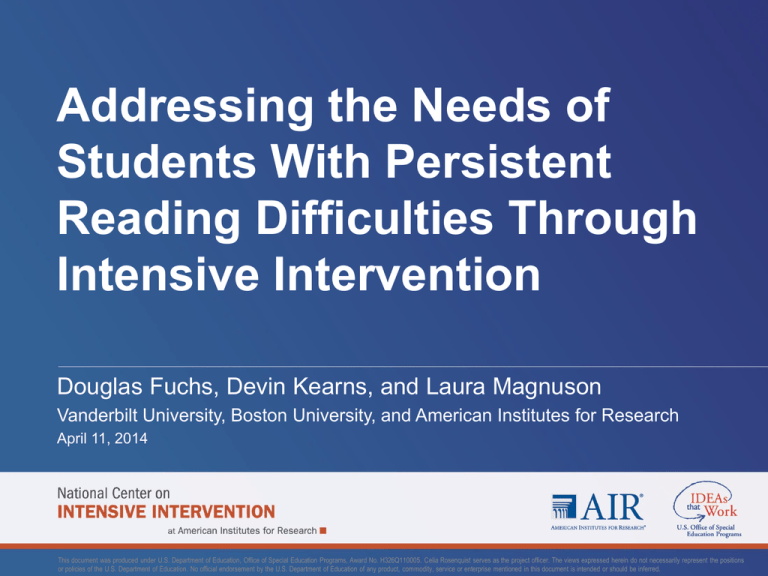
Addressing the Needs of Students With Persistent Reading Difficulties Through Intensive Intervention Douglas Fuchs, Devin Kearns, and Laura Magnuson Vanderbilt University, Boston University, and American Institutes for Research April 11, 2014 This document was produced under U.S. Department of Education, Office of Special Education Programs, Award No. H326Q110005. Celia Rosenquist serves as the project officer. The views expressed herein do not necessarily represent the positions or policies of the U.S. Department of Education. No official endorsement by the U.S. Department of Education of any product, commodity, service or enterprise mentioned in this document is intended or should be inferred. Session Overview 1. The intensive intervention framework (5 min.) 2. Overview of Data-Based Individualization (DBI) in reading (10 min.) 3. Critical elements of DBI in reading (25 min.) 4. Important considerations for making DBI work (5 min.) 5. Group discussion (15 min.) 2 The Intensive Intervention Framework 3 What Is Intensive intervention? Intensive intervention addresses severe and persistent learning or behavior difficulties. Intensive intervention should be: Driven by data Characterized by increased intensity (e.g., smaller group, expanded time) and individualization of academic instruction and/or behavioral supports 4 Five DBI Steps 1. Secondary intervention program, delivered with greater intensity 2. Progress monitoring 3. Informal diagnostic assessment 4. Adaptation 5. Continued progress monitoring, with adaptations occurring whenever needed to ensure adequate progress 5 A Bird’s Eye View of DBI 6 Overview of DBI in Reading: Why Do We Do DBI? 7 Why? Many Students With Disabilities Are Struggling in School U.S. elementary-age children with learning disabilities (LD) below 20th percentile on comprehension High school students with LD years below grade level in reading 64% 3.4 years Fraction of high school students with LD who drop out ¼ Percentage of students with LD with paid employment, two years postsecondary 46% 8 Why? Unfounded and Naïve Beliefs About Teaching Kids with LD “Virtually all children and youth with disabilities, including those with very serious learning problems, are helped sufficiently by the core curriculum with co-teaching, modifications to the core instructional program, or other such supports.” Fuchs, Fuchs, & Vaughn, 2014, p. 14 9 Why? Primary and Secondary Prevention Often Are Not Enough The Medical Analogy: High Blood Pressure Treatment Inexpensive diuretics Beta-blockers ACE inhibitors Other novel, patient-specific treatments Low-salt diet Stress reduction 10 A Case Study: Kelsey In fourth grade Reads at a second-grade level Participated in a secondary intervention using a research-validated program Group of six Explicit instruction 30 minutes, 4 times a week, for 7 weeks Led by knowledgeable paraprofessional 11 Kelsey’s Secondary Intervention Progress Progress monitored on a measure of passage reading fluency Baseline Initial Instruction Instructional Change Number of w ords read correctly in 1 minute 140 120 100 Goal Line 80 Her aim/goal line (where we want her weekly scores to be) 60 40 Her progress (her actual scores) 20 0 Date 12 Kelsey Is Not Responding to Secondary Prevention Kelsey is exactly the type of child who needs intensive intervention. • Kelsey received good instruction. Many children in intensive intervention participated in good programs. Their problems are not anyone’s “fault.” • Kelsey needs a more intensive instructional program. Some children just need more time structure practice clarity different methods of explanation content teacher attention 13 After Secondary Prevention: What Do We Do for Kelsey Now? Secondary intervention delivered with fidelity Non-Responders Does student need a smaller group? Does student need more time in intervention? Does student have problem with attention/ motivation? Secondary Intervention with… Smaller group 1:1 intervention Secondary Intervention with… Secondary Intervention with… and/ or Additional sessions More sessions per week More minutes per session and/ or Strategies to promote attention/ engagement Non-Responders Qualitative Changes to Intervention based on assessment data, including, but not limited to… Change interventionist Adjust language/vocabulary use Explicit instruction and error correction Modified response format 14 Data-Based Individualization Improving Skills for Students With Intensive Needs 15 Steps of DBI in Reading 1. 2. 3. 4. 5. Secondary prevention with greater intensity Progress monitoring Diagnostic assessment Adaptation of the intervention Iterations • 5A. Progress monitoring 1 2 3 4 • 5B. Analysis • 5C. Adaptation Danielson & Rosenquist, 2014; Lemons, Kearns, & Davidson, 2014 5 16 Secondary Prevention With Greater Intensity 17 Secondary Prevention With Greater Intensity Secondary prevention program • Not an approach or a loosely structured set of activities • Research-validated program (tested by researchers) • Clear sequence of lessons • Explicit instruction (I do, we do, you do) approach (Archer & Hughes, 2011) • Fidelity of implementation Greater intensity (quantitative changes) • Greater frequency, length of sessions, or duration • Smaller group size • Less heterogeneity in the group (students more similar in level) 18 Kelsey’s Secondary Prevention Program Research-Based (Fuchs, Kearns et al., 2012) Explicit Systematic Focused on Foundational Skills Sight words Sound-symbol correspondence Decoding Spelling Reading level-appropriate texts 19 Kelsey’s Progress After Secondary Prevention Slight improvement in oral reading fluency rate, and accuracy Oral reading fluency (accuracy; %) Oral reading fluency (rate) MAZE 20 Intensifying Secondary Prevention: Quantitative Changes Time 4 days 5 days Group 4 students 3 students 21 Progress Monitoring 22 Choose a Progress Monitoring (PM) Measure Reliable and valid measure (evaluated by researchers) • Use “Academic Progress Monitoring Tools Chart” available at intensiveintervention.org Easy-to-administer measure • Takes little teacher and student time • Easy to score Measure can be given weekly • Enough parallel forms • Designed for regular administration 23 Collect Initial Data and Create an Aimline Determine the correct level • Student’s instructional level • Not student’s grade level Determine student’s aim and plot it Kelsey is doing second-grade oral reading fluency • Using second-grade benchmark (85) or • Using second-grade expected rate of improvement (to 72) 24 Collect Data Through Initial DBI Collect data weekly After seven weeks (8 data points), evaluate progress Is student tracking the aimline? • Yes—stay on target • Above—increase the goal or stay on target • Below—diagnose and adapt instruction 25 Diagnostic Assessment 26 Informal Diagnostic Assessment Error analysis of PM data Classroom assessments and work samples Standardized assessments (if possible) 27 Using the Assessment Results 1. Review the diagnostic assessments 2. Come up with a theory about what might be causing the student’s academic difficulty 3. Start considering adaptations Spellings include all sounds Replaces nonwords bunny vu… IDK with real words knife twin Good sight word knowledge PM errors are mainly spinfor…polysyllabic IDK count? words 28 Adaptation 29 Adaptation for Kelsey: Quantitative Changes 20 minutes with teacher in small group, rather than 15 minutes 5 minutes of one-to-one time with teacher 15 minutes of partner practice, rather than whole-group reading activities in general education 30 Adaptation for Kelsey: Qualitative Changes Skip ahead in the scope and sequence to the polysyllabic lessons Supplement with polysyllabic strategies … Polysyllabic Strategy Options Lovett, Lacarenza, & Borden, 2000 Peeling off “I peel off (affix) at the beginning (or end) of the word. The root is ____. The word is ____.” (p. 468) Archer, Gleason, & Vachon, 2002 Vowel alert “First, I will try /first pronunciation/, then I will try /second pronunciation/, and see which gives me a real word.” (p. 469) Overt strategy Covert strategy 32 32 Polysyllabic Strategy Options DISSECT BEST Lenz & Hughes, 1990 O’Connor et al., 2002; O’Connor, Fulmer, Harty, & Bell, 2005; O’Connor & Bell, 2004 Discover the context Isolate the word’s prefix Separate the word’s suffix Say the word’s stem or base word Examine the word’s stem Check with another person Try to find the word in the dictionary Break the word apart Examine each part Say each part Try the whole thing in context Mnemonic strategies Polysyllabic Strategy Options Wilson, 2002 Syllable marking Lindamood & Lindamood, 1998 Tracking with syllables 34 Polysyllabic Strategy Chosen How to decide: • Think about the principles for intensive intervention – Which strategies have small steps? – Which strategies have precise language (3Cs language: clear, concise, consistent)? – Which strategies lend themselves to modeling real reading behavior? Choices • Peeling off • Vowel alert • Overt and covert strategies 35 Results of Adaptation 36 Iterations 37 Check Progress Weekly: Are the Adaptations Still Working? 38 After Four Points Below the Line, Diagnose and Adapt Again What should we do now? Diagnose: What is the source of the problem? Adapt: How can we change the program again to produce greater growth? 39 Important Considerations for Making DBI Work Tips From Our Work in Schools 40 Make Sure You Choose a Valid and Reliable PM System Running records Program-specific mastery measures 41 The Instructional Platform Is a PROGRAM An adequate resource but not an instructional platform: Not systematic and explicit 42 The Instructional Platform Is a PROGRAM An adequate website with actual lesson plans, but it is not a program that is tightly and carefully designed 43 The Adaptations Make Sense Brain workouts Neurofeedback training Working memory treatment Balance training To date, few scientific studies suggest these “cognitive” approaches work: Stick to academics Kearns & Fuchs (2013) 44 Monitor Progress Enough Every other week is not enough during DBI. Weekly monitoring is needed to show small changes. 45 Make Sure All Key Individuals Come to DBI Meetings Do not forget to loop them in early in the process. Make sure the entire staff knows about DBI and basically what will happen. Include other service providers, such as speech pathologists, who may have insight and ideas. 46 NCII Resources Tools Charts • Academic Intervention: http://www.intensiveintervention.org/chart/instructional-intervention-tools • Progress Monitoring: http://www.intensiveintervention.org/chart/progress-monitoring 47 NCII Resources DBI Training Series http://www.intensiveintervention.org/content/dbi-trainingseries Webinars http://www.intensiveintervention.org/resources/webinars • Register now for our April 29th webinar: “So What do I do Now? Strategies for Intensifying Intervention when Standard Approaches Don’t Work” 48 Group Discussion 49 References Archer, A. L., Gleason, M.,,& Vachon, V. (2002). REWARDS (Reading Excellence: Word Attack & Rate Development Strategies). Longmont, CO: Sopris West. Archer, A. L., & Hughes, C. A. (2011). Explicit instruction: Effective and efficient teaching. New York, NY: Guilford. Danielson, L., & Rosenquist, C. (2014). Introduction to the TEC special issue on data-based individualization. TEACHING Exceptional Children, 46, 6–12. Fuchs, D., Fuchs, L. S., & Vaughn, S. (2014). What is intensive instruction and why is it important?. TEACHING Exceptional Children, 46, 14. Lemons, C. J., Kearns, D. M., & Davidson, K. A. (2014). Data-based individualization in reading: Intensifying interventions for students with significant reading disabilities. TEACHING Exceptional Children, 46, 20–29. Lenz, B. K., & Hughes, C. A. (1990). A word identification strategy for adolescents with learning disabilities. Journal of Learning Disabilities, 23, 149–158, 163. Lindamood, P., & Lindamood, P. (l998). The Lindamood Phoneme Sequencing program for reading, spelling, and speech, Austin, TX: PRO-ED, Inc. Lovett, M. W., Lacerenza, L., & Borden, S. L. (2000). Putting struggling readers on the PHAST track: A program to integrate phonological and strategy-based remedial reading instruction and maximize outcomes. Journal of Learning Disabilities, 33, 458–476. O’Connor, R. E., Bell, K. M., Harty, K. R., Larkin, L. K., Sackor, S., & Zigmond, N. (2002). Teaching reading to poor readers in the intermediate grades: A comparison of text difficulty. Journal of Educational Psychology, 94, 474–485. O’Connor, R. E., & Bell, K. M. (2004). Teaching students with reading disability to read words. In A. Stone, E. Silliman, B. Ehren, & K. Apel (Eds.), Handbook of language and literacy: Development and disorders (pp. 479–496). New York, NY: Guilford Press. O’Connor, R. E., Fulmer, D., Harty, K., & Bell, K. (2005). Layers of reading intervention in kindergarten through third grade: Changes in teaching and child outcomes. Journal of Learning Disabilities, 38, 440–455. Wilson, B. (2002). The Wilson Reading System. Millbury, MA: Wilson Language Training. 50 Disclaimer This module was produced under the U.S. Department of Education, Office of Special Education Programs, Award No. H326Q110005. Celia Rosenquist serves as the project officer. The views expressed herein do not necessarily represent the positions or polices of the U.S. Department of Education. No official endorsement by the U.S. Department of Education of any product, commodity, service, or enterprise mentioned in this website is intended or should be inferred. 51 National Center on Intensive Intervention 1000 Thomas Jefferson Street NW Washington, DC 20007-3835 866-577-5787 www.intensiveintervention.org Email: ncii@air.org 52
